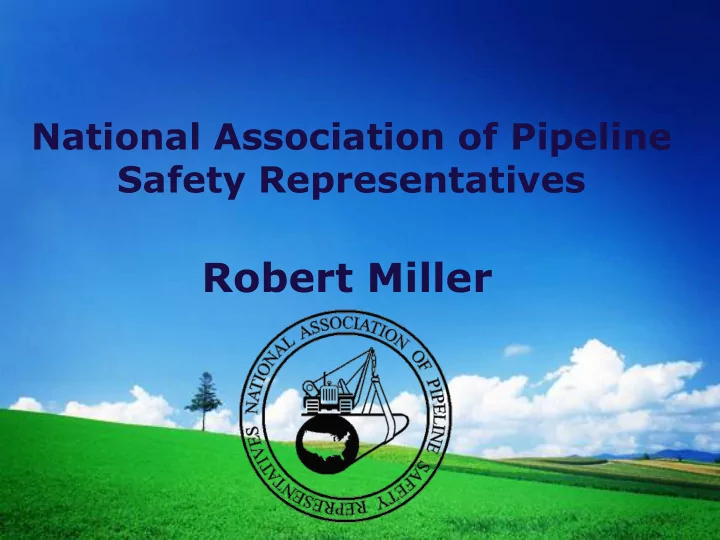

National Association of Pipeline Safety Representatives Robert Miller
NAPSR – MEANINGFUL METRICS NAPSR - is the national association representing the State pipeline safety programs in the contiguous United States as well as the District of Columbia and Puerto Rico.
NAPSR – MEANINGFUL METRICS State pipeline safety personnel make up more than 75% of the State/federal inspection workforce. NAPSR provides these inspectors with a venue to share best practices, enhance communications with our federal counterparts, raise new issues, and influence policy.
NAPSR – MEANINGFUL METRICS NAPSR is recognized by PHMSA, Congress, NARUC, numerous other federal agencies, and the media as the national voice of the State Pipeline Safety community. NAPSR members have direct safety authority over more than 96% of regulated intrastate gas systems and 32% of intrastate hazardous liquid systems in the U.S.
NAPSR – MEANINGFUL METRICS State pipeline safety programs have been partially funded by the federal government since the 1968 Pipeline Safety Act. Each state receiving federal funding does so with the understanding that we must maintain our programs in accordance with our federal certification guidelines.
NAPSR – MEANINGFUL METRICS Today, as in the past, states are continuing to work hard to maintain their safety programs at a level that not only meets the needs and expectations of their state but also the needs of our federal partners in accordance with our state certification program.
NAPSR – MEANINGFUL METRICS Although each state program is required to follow the guidelines established through our certification program, due to the uniqueness of each state and the pipeline operators within each state, we are allowed to establish additional pipeline safety regulations provided; these rules are as stringent or more stringent as current federal regulations.
NAPSR – MEANINGFUL METRICS As many of you here today can attest to, states are not hesitant when it comes to establishing new regulations relevant to the safe operation of an intrastate pipeline within their jurisdiction. As reported in the recently released Compendium of State Pipeline Regulations as of September 2013 the total number state initiatives is 1361 in 2011 that number was 1154; an increase of 207 new initiatives. For a copy of the full report go to www.napsr.org
NAPSR – Meaningful Metrics - NTSB The NTSB Safety Recommendation: Following the San Bruno incident the NTSB concluded that “ PHMSA had not incorporated the use of meaningful metrics as part of its guidance for effective performance-based pipeline safety management programs ” As defined, Performance-based management systems are activities designed to ensure that goals are consistently being met in an effective and efficient manner. ¡
Joint - Meaningful Metric Task Force aka – Development and Application of Meaningful Metrics (DAMM) Committee Purpose: To improve the process by which state programs are currently evaluated by PHMSA by establishing new evaluation metrics designed to measure and enhance the effectiveness of state programs, to provide additional consistency in the evaluation process and provide the states with additional guidance for making meaningful improvements in their safety programs.
MMTF - Members Members: NAPSR - Program Managers Peter Chace - Ohio Paul Metro - Pennsylvania Robert Miller – Arizona Bobby Henry - Arkansas Steve Pott - Colorado Members: PHMSA – State Program Oversight Zack Barrett Rex Evans Jim Anderson Don Martin ¡ ¡ ¡ ¡
MMTF – Progress Our group was formed shortly following the NTSB recommendation and has been working to develop a process that addresses the NTSB recommendation. It was not our teams goal to eliminate the current evaluation process but to supplement the current program with an additional layer of elements designed to produce a meaningful & measurable evaluation of state programs that can be applied to all states and which will result in state pipeline safety program improvements.
MMTF – Progress From the NAPSR perspective it has been our goal to assist PHMSA in finding a process by which state evaluations can be a true reflection of the work we are doing and how we can improve on those efforts It has not been our goal to reinvent the wheel by completely changing the way PHMSA currently evaluates our state programs
MMTF – Progress When determining what metric should be considered for evaluating a state program we began by established the following guidelines for our group; 1. Is it measurable 2. Is it data driven 3. Does it meet the goal of zero incidents and zero unintentional releases 4. Is it meaningful as an element and an essential component to an effective safety program
MMTF – The Metric Our current list of elements we have determined to be essential to an effective safety program are, - Damage Prevention - Inspection activities - Inspector Training and Qualifications - Leak Management - Enforcement - High Risk Pipeline Infrastructure - Incident/Accident Investigation Process ¡
MMTF - Metric Each identified metric incorporates; 1. a description of the Metric 2. a statement concerning the relevance / importance of the metric 3. the data source(s) necessary for collecting the data necessary for an adequate evaluation. 4. a listing of unique considerations based on an individual states set of circumstances 5. a listing of AAs, Additional Actions that a state could incorporate into their programs in order to make improvements to their programs (similar to industry best practices)
MMTF In conclusion: I would like to thank all the members of the our DAMM committee for their time and effort working on this important project. I believe that the work we are doing today will provide positive results in enhancing how PHMSA evaluates the work being done by State Programs while at the same time providing a useful tool for individual states to use in determining their best paths forward to improve pipeline safety within their state. ¡
QUESTIONS?
Recommend
More recommend